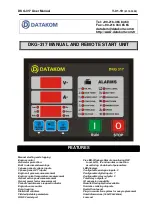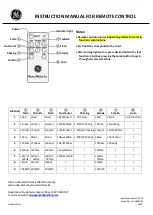
DKG-317 User Manual V-01.19
(01.10.2009)
- 8 -
4. ALARMS AND WARNINGS
Alarms indicate an abnormal situation in the generating set are divided into 2 priority levels:
1-
ALARMS:
These are the most important fault conditions and cause:
-
The related alarm led to be on steadily,
-
The engine to be stopped immediately,
-
The
Horn
,
Alarm
and
Alarm+Warning
relays output to operate, (if selected via
programming menu)
2-
WARNINGS:
These conditions cause:
-
The related alarm led to flash,
-
The
Horn
and
Alarm+Warning
relay outputs to operate, (if selected via programming
menu)
If the
ALARM MUTE
button is pressed, the Horn relay output will be deactivated; however the existing
alarms will persist and disable the operation of the genset.
Alarms operate in a first occurring basis:
-If an alarm is present, following alarms and warnings will not be accepted,
-If a warning is present, following warnings will not be accepted.
Alarms may be of LATCHING type following programming. For latching alarms, even if the alarm
condition is removed, the alarms will stay on and disable the operation of the genset.
The existing alarms may be canceled by pressing the
OFF
button.
Most of the alarms have programmable trip levels. See the programming chapter for settable alarm
limits.
LOW OIL PRESSURE:
Set if a signal is detected at the Low Oil Pressure Switch input or the oil pressure
value measured from the sender is below the programmed limit.
Warning
(
P_015
) and
alarm
(
P_016
) limits
are separately programmable for the oil pressure sender input. This fault will be monitored with holdoff timer
(
P_023
) delay after the engine is running. Also if the oil pressure switch is open at the beginning of a start
attempt, then the engine will not be started and the oil pressure led will flash. When the oil pressure switch
closes normal operation will be resumed.
HIGH TEMPERATURE:
Set if a signal is detected at the High Temperature Switch input or the coolant
temperature value measured from the sender is above the programmed limit.
Warning
(
P_017
) and
alarm
(
P_018
) limits are separately programmable for the temperature sender input.
SPEED:
Set if the generator frequency is outside programmed limits (overspeed/Underspeed). This fault will
be monitored with holdoff timer (
P_023
) delay after the engine is running. Different low and high limits for
warning and alarm are separately programmable. (P_008/P_009/P_010/P_011)
START FAIL:
Set if the engine is not running after programmed number of start attempts. (
P_035
)
STOP FAIL:
Set if the engine has not stopped before the expiration of the
Stop Timer (P_034)
.
OVERLOAD:
Set if at least one of the genset phase currents goes over the
Overcurrent Limit (P_002)
or if
the genset power (KW) supplied to the load goes over the
Excess Power (P_003)
limit for
Overcurrent /
Excess Power Timer (P_511)
. If the currents and power goes below the limits before expiration of the timer
then no alarm will be set.
VOLTAGE:
Set if any of the generator phase voltages goes outside programmed limits (P_006/P_007). This
fault will be monitored with holdoff timer (
P_023
) delay after the engine is running.
COOL: LEVEL:
Set when a signal is detected from the coolant level switch input.
BATTERY:
Set if the battery voltage goes outside programmed limits. During engine cranking this fault is not
monitored. Warning level for low battery voltage (P_012) and both warning (P_013) and alarm (P_014) levels
for high battery voltage are programmable.
CHARGE:
Set if a charge alternator failure (or broken belt) occurs. This fault condition may result to a
warning
or
alarm
following programming. (P_038)
RECTIFIER FAIL:
Set if a signal is detected at the rectifier fail input. This input is only monitored when mains
voltages are present.
EMERGENCY STOP:
Set if a signal is detected at the emergency stop input.
SPARE:
Set if a signal is detected in one of the spare fault inputs.









































